Table of Contents
<!-- Template Revision 1.64 (HTML comments will be not displayed in the document, no need to remove them. For Template/Skeleton changes, increase Template Revision number. So we can check faster, if the TRM style is up to date). --> |
Download PDF version of this document. |
Table of Contents |
Refer to https://wiki.trenz-electronic.de/display/DRAFT/TE0723+TRM for downloadable version of this manual and additional technical documentation of the product. |
Additional assembly options are available for cost or performance optimization upon request.
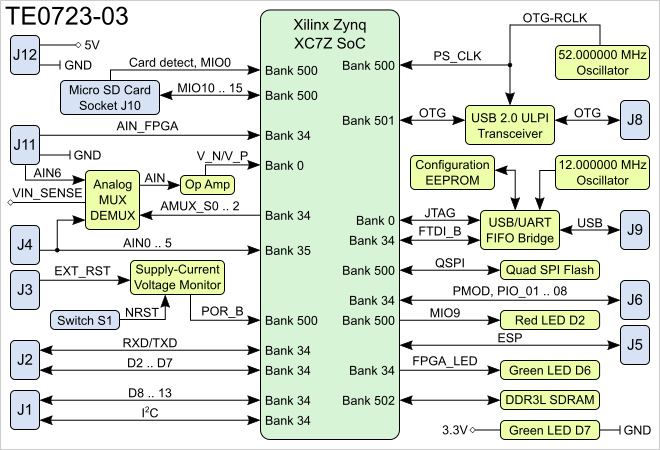
Figure 1: TE0723 block diagram.
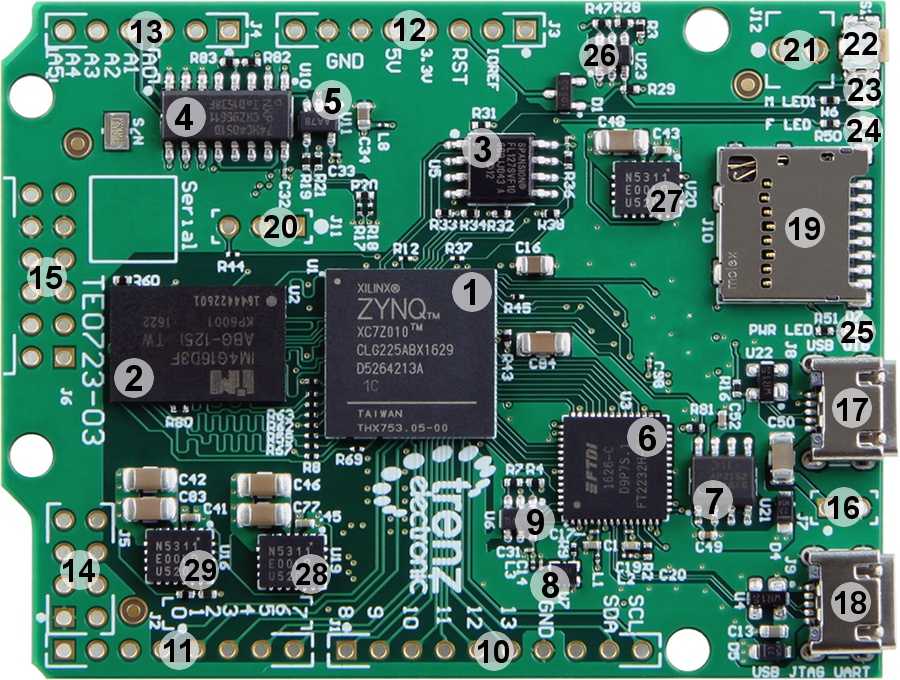
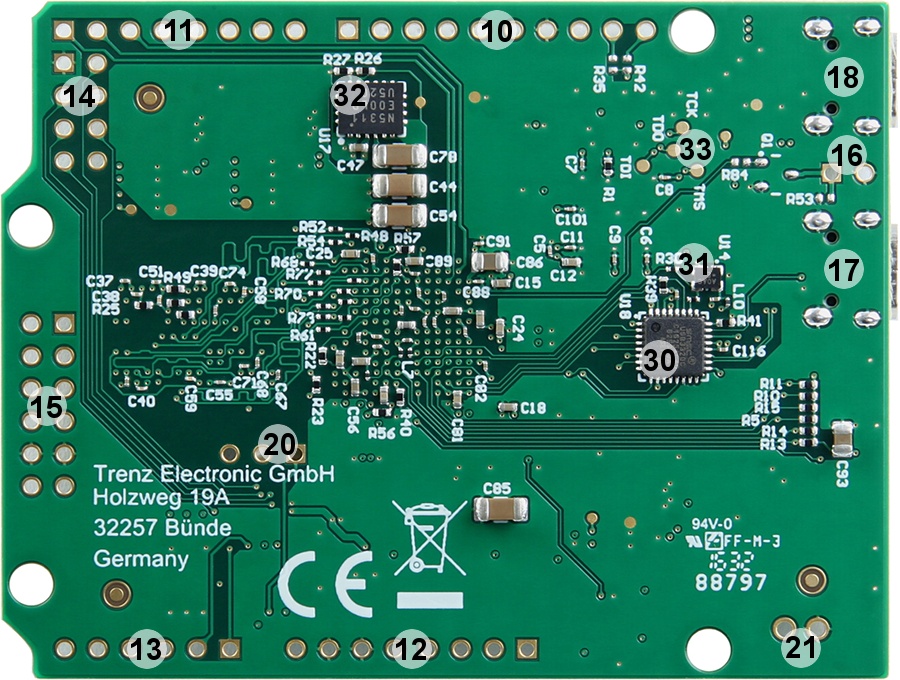
Figure 2: Main components of the TE0723 module.
High-speed CMOS logic analog multiplexer/demultiplexer, U10
1A PowerSoC DC-DC converter (3.3 V), U20
Storage device name | IC | Content | Notes |
|---|---|---|---|
Quad SPI Flash | U5 | Empty | |
| Microwire serial EEPROM | U6 | Empty |
Table 1: Initial delivery state of programmable devices on the module.
The 7 boot mode strapping pins on the TE0723 module are set to boot the system from quad SPI Flash only. For additional information refer to the TE0723 schematic and Xilinx UG585 Zynq-7000 All Programmable SoC Technical Reference Manual section "Boot Mode Pin Settings".
You may also refer to this TE0723 reference design for some Boot Process tips.
Overview of the Zynq SoC's PS/PL banks I/O signals connected to the external connectors:
| Bank | Type | Connector | Signal Count | Voltage | Notes |
|---|---|---|---|---|---|
| 34 | HR | J1 | 8 | 3.3V | D8 .. 13, SDA, SCL |
| 34 | HR | J2 | 8 | 3.3V | D2 .. 7, RXD, TXD |
| 34 | HR | J6 | 8 | 3.3V | PIO01 .. PIO08 |
| 35 | HR | J4 | 6 | 3.3V | AIN0 .. 5 |
| 35 | HR | J5 | 1 | 3.3V | ESP_GPIO2 |
| 500 | MIO | J10 | 7 | 3.3V | SDCARD |
| 501 | MIO | J5 | 4 | 3.3V | ESP_RXD, ESP_TXD, ESP_GPIO0, MOD_RST |
Table 2: Overview of the Zynq SoC's PS/PL banks I/O signals.
JTAG access to the Xilinx Zynq XC7Z010 SoC is provided through FTDI USB/UART FIFO bridge connected to the J9 Micro USB connector.
Quad SPI Flash (U5) is connected to the Zynq PS QSPI0 interface via PS MIO bank 500, pins MIO1 ... MIO6.
| Zynq SoC's MIO | Signal Name | U5 Pin |
|---|---|---|
| 1 | SPI0_CS | 1 |
| 2 | SPI0_DQ0/MIO2 | 5 |
| 3 | SPI0_DQ1/MIO3 | 2 |
| 4 | SPI0_DQ2/MIO4 | 3 |
| 5 | SPI0_DQ3/MIO5 | 7 |
| 6 | SPI0_SCK | 6 |
Table 3: Quad SPI interface signals and connections.
TE0723 module has on-board 3.3V SD Card socket (J10) with card detect switch wired to the SoC PS MIO bank 500.
| Zynq SoC's Pin | Connected To | Signal Name |
|---|---|---|
| MIO0 | J10-9 | Card detect switch |
| MIO10 | J10-7 | DAT0 |
| MIO11 | J10-3 | CMD |
| MIO12 | J10-5 | CLK |
| MIO13 | J10-8 | DAT1 |
| MIO14 | J10-1 | DAT3 |
| MIO15 | J10-2 | CD/DAT3 |
Table 4: SD card socket signals.
| Zynq SoC's Pin | Connected To | Signal Name |
|---|---|---|
| MIO28 | U18-7 | OTG-DATA4 |
| MIO29 | U18-31 | OTG-DIR |
| MIO30 | U18-29 | OTG-STP |
| MIO31 | U18-2 | OTG-NXT |
| MIO32 | U18-3 | OTG-DATA0 |
| MIO33 | U18-4 | OTG-DATA1 |
| MIO34 | U18-5 | OTG-DATA2 |
| MIO35 | U18-6 | OTG-DATA3 |
| MIO36 | U18-1 | OTG-CLK |
| MIO37 | U18-9 | OTG-DATA5 |
| MIO38 | U18-10 | OTG-DATA6 |
| MIO39 | U18-13 | OTG-DATA7 |
Table 5: USB interface.
Interface for the ESP8266 Wi-Fi module is provided through connector J5.
| Zynq SoC's Pin | Connected To | Signal Name |
|---|---|---|
| MIO48 | J5-2 | ESP_TXD |
| MIO49 | J5-7 | ESP_RXD |
| MIO52 | J5-6 | MOD_RST |
| MIO53 | J5-3 | ESP_GPIO0 |
Table 6: ESP8266 Wi-Fi module interface.
I2C interface pins SCL and SDA from the Zynq SoC PL bank 34 are connected to the connector J1. There are no on-board I2C slave devices.
| Zynq SoC's Pin | Connected To | Signal Name |
|---|---|---|
| R13 | J1-9 | SDA |
| P13 | J1-10 | SCL |
Table 7: Zynq SoC I2C interface.
TE0723 module has up to 512-MBytes of DDR3L SDRAM arranged into 32-bit wide memory bus providing total of 1 GBytes of on-board RAM. Different memory sizes are available optionally.
On-board quad SPI Flash memory S25FL127S (U5) is used to store initial FPGA configuration. Besides FPGA configuration, remaining free flash memory can be used for user application storage. All four SPI data lines are connected to the Zynq SoC's PS, allowing x1, x2 or x4 data bus widths. Maximum data rate depends on the bus width and clock frequency used.
FT2232H...
Hi-speed USB ULPI PHY (U18) is provided with USB3320 from Microchip. The ULPI interface is connected to the Zynq SoC's PS USB0 via MIO28..39, bank 501 (see also section). The I/O voltage is fixed at 3.3V and PHY reference clock input is supplied from the on-board 52.000000 MHz oscillator (U14).
There is a 2-Kbit (128 x 16-bit organization) Microwire compatible serial EEPROM 93AA56B (U6) connected to the FTDI FT2232H dual high-speed USB to multipurpose UART/FIFO (U3). This external EEPROM allows each of the FTDI FT2232H chip’s channels to be independently configured as a serial UART (RS232 mode), parallel FIFO (245) mode or fast serial (optical isolation). The external EEPROM can also be used to customize the USB VID, PID, serial number, product description strings and power descriptor value of the FT2232H for OEM applications. Other parameters controlled by the EEPROM include remote wake up, soft pull down on power-off and I/O pin drive strength.
TE0723 module has a on-board TI CD74HC4051 high-speed CMOS logic analog multiplexer (U10) with 8 analog inputs from connectors J4 and J11, and single analog output connected to the operational amplifier (see next section).
8-input analog multiplexer output is connected to the on-board Microchip Technology MCP6001 operational amplifier (U11). Amplifier output is connected to the Zynq SoC's PS bank 0, XADC dedicated differential analog input pins VP_0 and VN_0.
The module has following reference clock signals provided by on-board oscillators:
| Source | Signal | Frequency | Destination | Pin Name | Notes |
|---|---|---|---|---|---|
| U14 | PS_CLK | 52.000000 MHz | U1 | PS_CLK_500 | Zynq SoC PS subsystem main clock. |
| U14 | OTG-RCLK | 52.000000 MHz | U18 | REFCLK | USB3320C PHY reference clock. |
| U7 | OSCI | 12.000000 MHz | U3 | OSCI | FT2232H oscillator input. |
Table 8: Reference clock signals.
There are three LEDs on-board TE0723:
| LED | Color | Connected To | Description and Notes |
|---|---|---|---|
| D2 | Red | MIO9, U1 | User LED. |
| D6 | Green | U1, bank 34 pin G14 | FPGA_LED |
| D7 | Green | 3.3V | PWR_LED, power-on LED. |
Table 9: On-board LEDs.
5V power can be supplied by the external power supply through connector J12 or via USB connection to the host system through USB connector J8 or J9. Minimum current capability of 1A for external power supply is recommended.
Power consumption is to be determined by the user and depends on SoC's FPGA design and connected hardware.
There is no specific power-on sequence, system will power-up automatically when 5V is present either through J8, J9 or J12.
| Module Variant | Xilinx Zynq SoC | DDR3L SDRAM | ARM Cores | PL Cells | LUTs | Flip-Flops | Block RAM | DSP Slices |
|---|---|---|---|---|---|---|---|---|
| TE0723-02 | XC7Z010-1CLG225C | 128 MBytes | Dual-core | 28K | 17,6K | 35,2K | 2.1 MBytes | 80 |
| TE0723-03M | XC7Z010-1CLG225C | 512 MBytes | Dual-core | 28K | 17,6K | 35,2K | 2.1 MBytes | 80 |
| TE0723-03-07S-1C | XC7Z007S-1CLG225C | 512 MBytes | Single-core | 23K | 14,4K | 28,8K | 1.8 MBytes | 66 |
Table 10: Module variants.
Parameter | Min | Max | Units | Reference Document |
|---|---|---|---|---|
VIN supply voltage | -0.5 | 3.6 | V | Xilinx datasheet DS187. |
Storage temperature | -40 | +85 | °C |
Table 11: TE0723 module absolute maximum ratings.
| Parameter | Min | Max | Units | Reference Document |
|---|---|---|---|---|
| Supply voltage | 1.14 | 3.465 | V | Xilinx datasheet DS187. |
Table 12: TE0723 module recommended operating conditions.
| Assembly variants for higher storage temperature range are available on request. |
Module size: 68.58 mm × 53.34 mm. Please download the assembly diagram for exact numbers.
PCB thickness: 1.6 mm.
Highest part on PCB: approx. 4 mm. Please download the step model for exact numbers.
Please note that two different units are used on the figures below, SI system millimeters (mm) and imperial system thousandths of an inch(mil). To convert mils to millimeters and vice versa use formula 100mil's = 2,54mm.
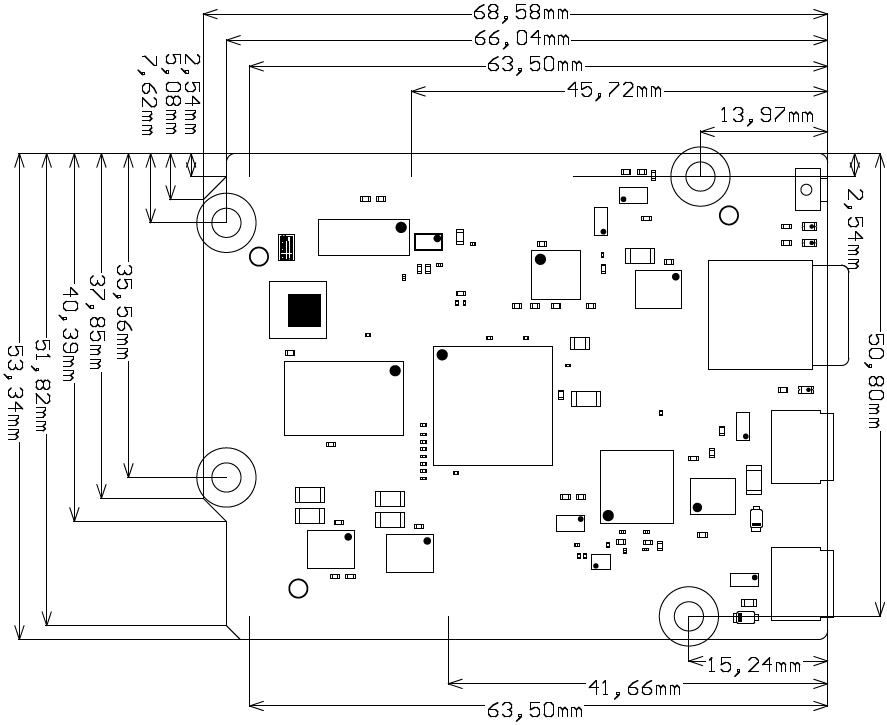
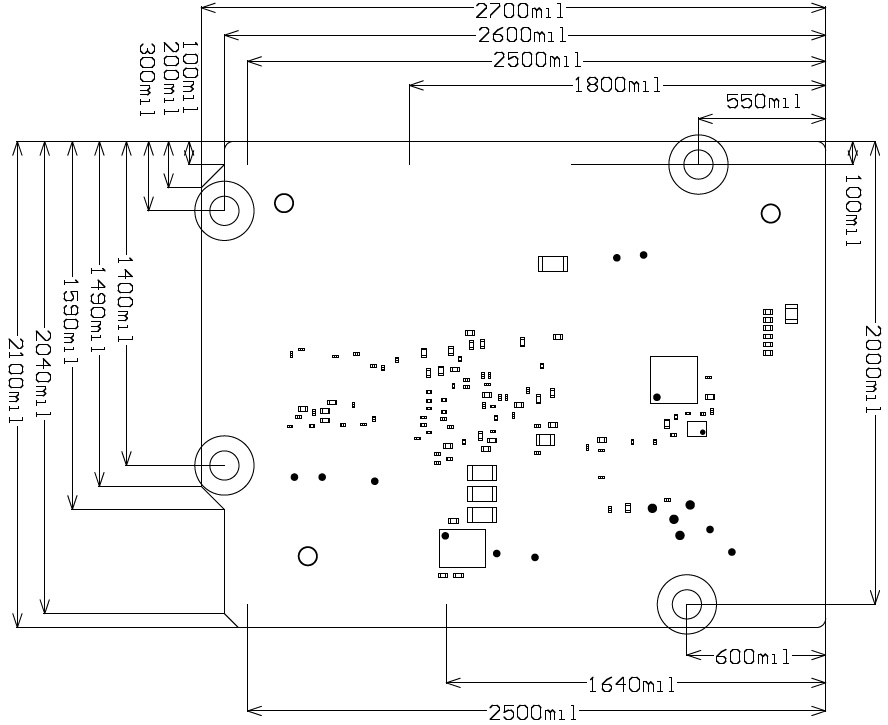
Figure 3: TE0723 module physical dimensions.
Commercial grade: 0°C to +70°C.
Industrial grade: -40°C to +85°C.
Operating temperature range depends also on customer design and cooling solution. Please contact us for options.
| Date | Revision | Notes | PCN | Documentation Link |
|---|---|---|---|---|
| 2016-07-15 | 03 | Click to see PCN. | TE0723-03 | |
2015-11-06 | 02 | TE0723-02 | ||
01 |
|
Table 13: TE0723 hardware revision history.
Hardware revision number is printed on the PCB board together with the module model number separated by the dash.
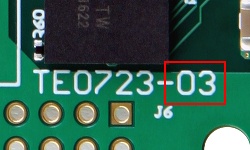
Date | Revision | Contributors | Description |
|---|---|---|---|
Jan Kumann | Initial document. |
Table 14: Document change history.